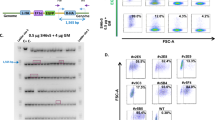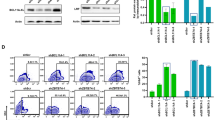Abstract
Locus control regions (LCRs) are transcriptional regulatory elements, which possess a dominant chromatin remodelling and transcriptional activating capability conferring full physiological levels of expression on a gene linked in cis, when integrated into the host cell genome. Using the human β-globin LCR (βLCR) as a model, we show that this class of control element can drive high levels of tissue-specific gene expression in stably transfected cultured cells from within an Epstein–Barr virus-based plasmid REV. Furthermore, a 38-kb βLCR minilocus-REV cosmid vector was efficiently retained and maintained therapeutic levels of β-globin transgene expression in the absence of drug selective pressure over a 2-month period of continuous culture equivalent to at least 60 generations. This demonstrates for the first time the feasibility of using REVs for gene therapy of the haemoglobinopathies. Importantly, our results demonstrate that as in the case of integrated transgenes, expression from within REVs is prone to silencing but that the inclusion of the βLCR prevented this repression of gene function. Therefore, appropriate control elements to provide and maintain tissue-specific gene expression, as well as the episomal status of REVs is a crucial feature in vector design. Our data suggest that LCRs can contribute to this vital function.
This is a preview of subscription content, access via your institution
Access options
Subscribe to this journal
Receive 12 print issues and online access
$259.00 per year
only $21.58 per issue
Buy this article
- Purchase on Springer Link
- Instant access to full article PDF
Prices may be subject to local taxes which are calculated during checkout






Similar content being viewed by others
References
Sclimenti C.R., Calos M.P. . Epstein–Barr virus vectors for gene expression and transfer Curr Opin Biotechnol 1998 9: 476 476
Sun T.Q., Fernstermacher D.A., Vos J.M. . Human artificial episomal chromosomes for cloning large DNA fragments in human cells Nat Genet 1994 8: 33 33
Satoh E. et al. Efficient gene transduction by Epstein–Barr virus-based vectors coupled with cationic liposome and HVJ-liposom Biochem Biophys Res Commun 1997 238: 795 795
Saeki Y., Wataya-Kaneda M., Tanaka K., Kaneda Y. . Sustained transgene expression in vitro and in vivo using an Epstein–Barr virus replicon vector system combined with HVJ liposomes Gene Therapy 1998 5: 1031 1031
Tsukamoto H. et al. Enhanced expression of recombinant dystrophin following intramuscular injection of Epstein–Barr virus (EBV)-based mini-chromosome vectors in mdx mice Gene Therapy 1999 6: 1331 1331
Yates J.L., Warren N., Sugden B. . Stable replication of plasmids derived from Epstein–Barr virus in various mammalian cells Nature 1985 313: 812 812
De Benedetti A., Rhoads R.E. . A novel BK virus-based episomal vector for expression of foreign genes in mammalian cells Nucleic Acids Res 1991 19: 1925 1925
Sabbioni S. et al. A BK virus episomal vector for constitutive high expression of exogenous cDNAs in human cells Arch Virol 1995 140: 335 335
Ohe Y., Zhao D., Saijo N., Podack E.R. . Construction of a novel bovine papillomavirus vector without detectable transforming activity suitable for gene transfer Hum Gene Ther 1995 6: 325 325
Cooper M.J. et al. Safety-modified episomal vectors for human gene therapy Proc Natl Acad Sci USA 1997 94: 6450 6450
Krysan P.J., Haase S.B., Calos M.P. . Isolation of human sequences that replicate autonomously in human cells Mol Cell Biol 1989 9: 1026 1026
Wohlgemuth J.G. et al. Long-term expression from autonomously replicating vectors in mammalian cells Gene Therapy 1996 3: 503 503
Reeves R., Gorman C.M., Howard B. . Minichromosome assembly of non-integrated plasmid DNA transfected into mammalian cells Nucleic Acids Res 1985 13: 3599 3599
Archer T.K., Lefebvre P., Wolford R.G., Hager G.L. . Transcription factor loading on the MMTV promoter: a bimodal mechanism for promoter activation Science 1992 255: 1573 1573
Cereghini S., Yaniv M. . Assembly of transfected DNA into chromatin: structural changes in the origin-promoter-enhancer region upon replication EMBO J 1984 3: 1243 1243
Smith C.L., Archer T.K., Hamlin-Green G., Hager G.L. . Newly expressed progesterone receptor cannot activate stable, replicated mouse mammary tumor virus templates but acquires transactivation potential upon continuous expression Proc Natl Acad Sci USA 1993 90: 11202 11202
Fraser P., Grosveld F. . Locus control regions, chromatin activation and transcription Curr Opin Cell Biol 1998 10: 361 361
Li Q., Harju S., Peterson K.R. . Locus control regions: coming of age at a decade plus Trends Genet 1999 15: 403 403
Kioussis D., Festenstein R. . Locus control regions: overcoming heterochromatin-induced gene inactivation in mammals Curr Opin Genet Dev 1997 7: 614 614
Antoniou M., Grosveld F. . Genetic approaches to therapy for the haemoglobinopathies Fairbairn LJ, Testa NG (eds); Blood Cell Biochemistry, Volume 8: Hematopoiesis and Gene Therapy Kluwer Academic/Plenum 1999 pp 219–242
May C. et al. Therapeutic haemoglobin synthesis in β-thalassaemic mice expressing lentivirus-encoded human β-globin Nature 2000 406: 82 82
Gahmberg C.G., Andersson L.C. . K562-a human leukemia cell line with erythroid features Semin Hematol 1981 18: 72 72
BlomvanAssendelft G., Hanscombe O., Grosveld F., Greaves D.R. . The β-globin dominant control region activates homologous and heterologous promoters in a tissue-specific manner Cell 1989 56: 969 969
Hirt B. . Selective extraction of polyma DNA from infected mouse cell culture J Mol Biol 1967 26: 365 365
Antoniou M., deBoer E., Grosveld F. . Fine mapping of genes: the characterization of the transcriptional unit Davies KE (eds); Human Genetic Disease Analysis. A Practical Approach IRL Press 1993 pp 83–108
Grosveld F., BlomvanAssendelft G.B., Greaves D.R., Kollias G. . Position-independent high level expression of the human β-globin gene in transgenic mice Cell 1987 51: 975 975
WadeMartins R. et al. Stable correction of a genetic deficiency in human cells by an episome carrying a 115 kb genomic transgene Nature Biotechnol 2000 18: 1311 1311
Hauer C.A., Getty R.R., Tykocinski M.L. . Epstein–Barr virus episome-based promoter function in human myeloid cells Nucleic Acids Res 1989 17: 1989 1989
Collis P., Antoniou M., Grosveld F. . Definition of the minimal requirements within the human β-globin gene and the dominant control region for high level expression EMBO J 1990 9: 233 233
Talbot D., Philipsen S., Fraser P., Grosveld F. . Detailed analysis of the site 3 region of the human β-globin dominant control region EMBO J 1990 9: 2169 2169
Philipsen S., Talbot D., Fraser P., Grosveld F. . The β-globin dominant control region: hypersensitive site 2 EMBO J 1990 9: 2159 2159
Pruzina S. et al. Hypersensitive site 4 of the human β-globin locus control region Nucleic Acids Res 1991 19: 1413 1413
Tuan D.Y., Solomon W.B., London I.M., Lee D.P. . An erythroid-specific, developmental stage-independent enhancer far upstream of the human ‘β-like globin’ genes Proc Natl Acad Sci USA 1989 86: 2554 2554
Ney P.A., Sorrentino B.P., McDonagh K.T., Nienhuis A.W. . Tandem AP-1-binding sites within the human β-globin dominant control region function as an inducible enhancer in erythroid cells Genes Dev 1990 4: 993 993
Ney P.A., Sorrentino B.P., Lowrey C.H., Nienhuis A.W. . Inducibility of the HS II enhancer depends on binding of an erythroid specific nuclear protein Nucleic Acids Res 1990 18: 6011 6011
Gong Q., McDowell J.C., Dean A. . Essential role of NF-E2 in remodelling of chromatin structure and transcriptional activation of the ɛ-globin gene in vivo by 5′hypersensitive site 2 of the β-globin locus control region Mol Cell Biol 1996 16: 6055 6055
Lei D.C. et al. Episomal expression of wild-type CFTR corrects cAMP-dependent chloride transport in respiratory epithelial cells Gene Therapy 1996 3: 427 427
Banerjee S., Livanos E., Vos J.M.H. . Therapeutic gene delivery in human B-lymphoblastoid cells by engineered non-transforming infectious Epstein–Barr virus Nature Med 1995 1: 1303 1303
Piechaczek C. et al. A vector based on the SV40 origin of replication and chromosomal S/MARs replicates episomally in CHO cells Nucleic Acids Res 1999 27: 426 426
Heinzel S.S., Krysan P.J., Tran C.T., Calos M.P. . Autonomous DNA replication in human cells is affected by the size and the source of the DNA Mol Cell Biol 1991 11: 2263 2263
Verma I.M., Somia N. . Gene therapy – promises, problems and prospects Nature 1997 389: 239 239
Antoniou M. . Induction of erythroid-specific expression in murine erythroleukemia (MEL) cell lines In: Murray EJ (eds) Methods in Molecular Biology: vol 7 Gene Transfer and Expression Protocols Humana Press 1991 pp 421–434
Sambrook J. . Molecular Cloning: A Laboratory Manual 2nd edn Cold Spring Harbor Laboratory Press 1989
Raguz S. et al. Muscle-specific locus control region activity associated with the human desmin gene Dev Biol 1998 201: 26 26
Auffray C., Rougeon F. . Purification of mouse immunoglobulin heavy-chain RNAs from total myeloma tumor RNA Eur J Biochem 1980 107: 303 303
Antoniou M., DeBoer E., Habets G., Grosveld F. . The human β-globin gene contains multiple regulatory regions: identification of one promoter and two downstream enhancers EMBO J 1988 7: 377 377
Kozu T., Henrich B., Schafer K.P. . Structure and expression of the gene (HNRPA2B1) encoding the human hnRNP protein A2/B1 Genomics 1995 25: 365 365
Ashe H.L. et al. Intergenic transcription and transinduction of the human β-globin locus Genes Dev 1997 11: 2494 2494
Reitman M., Lee E., Westphal H., Felsenfeld G. . An enhancer/locus control region is not sufficient to open chromatin Mol Cell Biol 1993 13: 3990 3990
Acknowledgements
We thank Bill Sugden for the p220.2 and cos203 EBV-based vectors. This work was initiated with support from Cobra Therapeutics (Keele, UK) and continued with funding under the European Union Framework IV Biomed-2 (contract No. BMH4-CT96-1279) and Biotechnology (contract No. BIO4-CT96-0414) programmes. AA was funded for this work by a European Union Marie Curie Fellowship (contract No. HPMF-CT-1994-00091).
Author information
Authors and Affiliations
Rights and permissions
About this article
Cite this article
Chow, CM., Athanassiadou, A., Raguz, S. et al. LCR-mediated, long-term tissue-specific gene expression within replicating episomal plasmid and cosmid vectors. Gene Ther 9, 327–336 (2002). https://doi.org/10.1038/sj.gt.3301654
Received:
Accepted:
Published:
Issue Date:
DOI: https://doi.org/10.1038/sj.gt.3301654
Keywords
This article is cited by
-
The β-globin Replicator greatly enhances the potential of S/MAR based episomal vectors for gene transfer into human haematopoietic progenitor cells
Scientific Reports (2017)
-
Advances in High-capacity Extrachromosomal Vector Technology: Episomal Maintenance, Vector Delivery, and Transgene Expression
Molecular Therapy (2008)
-
Gene transfer into human hematopoietic progenitor cells with an episomal vector carrying an S/MAR element
Gene Therapy (2006)
-
Genetic modification of hematopoietic stem cells with nonviral systems: past progress and future prospects
Gene Therapy (2005)



